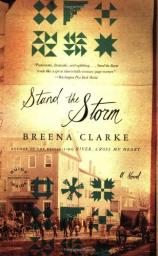Reading Group Guide
Discussion Questions
Stand the Storm

1. What surprised you most about the novel’s depiction of slave life in the mid-nineteenth century? Discuss some of the ways in which the lives of urban slaves differed from the lives of plantation-based slaves.
2. Is Sewing Annie Coats a good mother? Is she a good mother to Gabriel? to Ellen? If in your view Annie favors one child over the other, do you think she’s justified in doing so?
3. What special steps did Abraham Pearl take to insure that only Gabriel would read the part of his letter in which he revealed the existence of the chest filled with gold buttons? Do you think Pearl actually forgot to take the chest or did he deliberately leave it behind?
4. Stand the Storm is unsparing in its portrayal of the dangers faced by anyone who participated in the Underground Railroad. Discuss the particular case of Emily and Matthew Chester (pages 68–73). Was their murder necessary?
5. When Gabriel suffers a humiliating assault by Master Jonathan Ridley (page 108), he manages to resist fighting back. Is Gabriel’s response appropriate? Put yourself in his shoes; how would you have reacted? What might the consequences have been for Gabriel if he had responded differently?
6. Discuss the character Katharine Logan. When she first appears in the novel (page 89), she is an indentured servant on the Warren plantation. She is nominally a free white woman when, years later, she visits the Ridley tailoring shop in Georgetown (page 178) and attempts to reclaim the daughter she gave up at birth. Is Katharine’s life any less circumscribed than the Coatses’ lives? What opportunities does she enjoy in Civil War–era America that the Coatses do not?
7. What is the Reverend William Higgins’s secret? Was it by sheer luck that his life took the path it did? Do you think Reverend Higgins feels a special obligation to help the Blacks of Georgetown? Did his experiences in childhood make him a better clergyman than he might otherwise have been?
8. Discuss the significance of the wedding gift bestowed on Gabriel and Mary by Aaron Ridley and his mother (page 155). Why does this gift bring Sewing Annie to tears?
9. Why does Sewing Annie reject Daniel Joshua’s overtures (page 169)? Why will she not allow herself to become romantically involved with him?
10. Mary and Sewing Annie hold opposing views on whether to join one of Georgetown’s laundry syndicates. What benefits did these syndicates provide their members? Whose side would you have taken? Would you have argued against or in favor of joining a syndicate?
11. How did Ellen end up in the Blue Jug? Does it seem credible to you that an unprovoked incident seemingly so minor could have such dire repercussions?
12. In what ways are Jonathan and Mary Ridley typical slave owners? Do they exhibit any attitudes and behaviors that set them apart from other nineteenth-century slave owners in fiction or in the historical record?
13. In Chapter 14 we see Gabriel make a valiant effort to rescue other Blacks fleeing slavery: he ferries across the Potomac, at great personal risk and in hazardous conditions, a family who are strangers to him. Yet Gabriel seems willing to allow Delia, the girl his sister claims is her daughter, to be turned back over to Master Ridley and enslaved (page 209). How can Gabriel reconcile his actions in these two circumstances?
14. Identify a moment in Stand the Storm when one of the novel’s principal characters—Sewing Annie, Gabriel, Ellen, or Mary—feels unmitigated joy. How common was the experience of joy in these characters’ lives?
15. Discuss the ways in which the war changed Gabriel. How did it change the other members of the Coates family? Compare the Coatses’ experience with the experience of American families touched by war today.
16. “Annie surprised herself with longing for Ridley Plantation” (page 193). How, after buying her freedom, can Sewing Annie look back at plantation life—with its abundant rigors and indignities—with any fondness at all? What about Ridley Plantation do you think she misses?
17. Several months before President Lincoln issued his Emancipation Proclamation, the U.S. government freed the slaves residing in the nation’s capital. How were the Coatses, who at the time were living in Georgetown as free persons, endangered by Congress’s decree (page 197)? Which members of the Coats family were put most at risk? How were they saved?
18. Were you surprised by the turn of events at the end of Chapter 33? Even if such unforeseen tragedy is true to life, does it have a proper place in fiction?
19. Discuss the significance of the rain barrels that Sewing Annie installs in the yard behind the shop and uses to collect water for laundering (page 39). What happens to the rain barrels at the end of the novel?
20. Does slavery still exist in our 21st-century world? If so, where? how? and what could or should be done to eradicate it?
Stand the Storm
- Publication Date: June 24, 2009
- Paperback: 352 pages
- Publisher: Back Bay Books
- ISBN-10: 0316007056
- ISBN-13: 9780316007054








